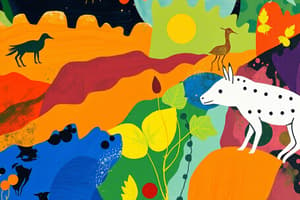Podcast
Questions and Answers
Which group of vascular plants has the highest percentage of threatened endemic species?
Which group of vascular plants has the highest percentage of threatened endemic species?
- Angiosperms
- Gymnosperms
- Pteridophytes (correct)
- Native Species
What percentage of the total vascular plants are considered threatened?
What percentage of the total vascular plants are considered threatened?
- 7.3%
- 8.8% (correct)
- 6.6%
- 9.7%
Among the given categories, which has the smallest number of non-vascular plant species reported?
Among the given categories, which has the smallest number of non-vascular plant species reported?
- Total Non-vascular Plants (correct)
- Hornworts
- Liverworts
- Mosses
Which class of vascular plants has a reported count of 42 and no naturalized species?
Which class of vascular plants has a reported count of 42 and no naturalized species?
What is the total reported number of angiosperm species in the context provided?
What is the total reported number of angiosperm species in the context provided?
What is a major consequence of the illegal wildlife trade on biodiversity?
What is a major consequence of the illegal wildlife trade on biodiversity?
Which of the following policies specifically targets the management of forestlands in the Philippines?
Which of the following policies specifically targets the management of forestlands in the Philippines?
Which of the following is NOT identified as a threat to biodiversity in the Philippines?
Which of the following is NOT identified as a threat to biodiversity in the Philippines?
Which plant species was discovered since 2015 as part of the botanical discoveries in the Philippines?
Which plant species was discovered since 2015 as part of the botanical discoveries in the Philippines?
What strategy does DMC No. 2004-06 promote in the Philippines?
What strategy does DMC No. 2004-06 promote in the Philippines?
Flashcards are hidden until you start studying
Study Notes
Vascular Plants Overview
- Total vascular plant species: 10,013
- Native species: 9,464
- Naturalized species: 549
- Endemic species: 4,822
- Threatened species: 970 (9.7% of total), with 730 (7.3%) being endemic
Plant Classification
- Angiosperms:
- Total: 8,923
- Native: 8,380
- Naturalized: 543
- Endemic: 4,537
- Threatened: 787 (8.8%)
- Gymnosperms:
- Total: 42
- Indigenous: 42
- Endemic: 16 (38.1%)
- Threatened: 25 (59.5%)
- Pteridophytes:
- Total: 1,048
- Native: 1,042
- Endemic: 263
- Threatened: 158 (15.1%)
- Non-vascular plants total over 1,200, with only a small percentage being threatened.
Discoveries in Plant Species Since 2015
- New species identified: 158
- Notable discoveries include Hypericum perryongii, Hornstedtia olivacea, and Rafflesia consueloae.
Biodiversity Threats
- Key threats to biodiversity in the Philippines:
- Deforestation
- Land degradation
- Climate change
- Pollution
- Invasive alien species
- Illegal wildlife trade
Relevant Policies and Legislative Framework
- Presidential Decree No. 705: Aims for proper classification and management of public domain lands.
- Executive Order No. 23 (2011): Imposes a moratorium on logging in natural forests and establishes an anti-illegal logging task force.
- DAO 2019-03: Updates the rules and regulations for expanding the National Greening Program.
- Republic Act 7586: Establishes the National Integrated Protected Areas System.
International Agreements
-
CITES (Convention on International Trade in Endangered Species):
- Ensures that international trade does not threaten the survival of wildlife.
- Prohibits illegal trade and allows for the confiscation of illegally traded specimens.
-
CBD (Convention on Biological Diversity):
- Objectives include conservation of biodiversity, sustainable use of resources, and equitable sharing of benefits.
- Kunming-Montreal Global Biodiversity Framework includes 4 goals and 23 targets focusing on conservation, sustainable use, equitable sharing, and implementation means.
Focus Areas of Kunming-Montreal Global Biodiversity Framework
- Goal A: Halt biodiversity loss and restore ecosystems.
- Goal B: Promote sustainable land and sea use.
- Goal C: Fair sharing of benefits from resources.
- Goal D: Enhance resource mobilization for implementation.
Studying That Suits You
Use AI to generate personalized quizzes and flashcards to suit your learning preferences.




